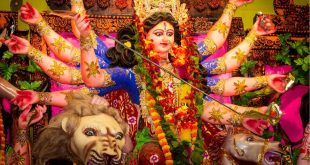Navratri 9 din 9 colour: Embrace the Vibrancy of Navratri with 9 Sacred Colors
Celebrating the Divine Essence of Navratri
Navratri, a festival celebrating the nine manifestations of Goddess Durga, holds profound significance in Hindu culture. Observed four times a year, Chaitra Navratri marks the beginning of the Hindu New Year. During these nine auspicious days, devotees adorn themselves and their surroundings with specific colors dedicated to each day’s deity. Let’s delve into the significance of these nine colors in Navratri and how they symbolize reverence towards the divine goddess.
Pratipada (First Day) – The Radiance of Yellow
The commencement of Navratri is marked by worshipping Goddess Shailputri, signifying the embodiment of nature’s power. Devotees adorn yellow attire on this day to symbolize purity and prosperity while performing Ghatasthapana (installation of the sacred pot).
Dwitiya (Second Day) – Embracing the Green Grace
On the second day, devotees venerate Goddess Brahmacharini, the epitome of love and loyalty. Green, the color of fertility and growth, is worn to honor her divine presence, signifying new beginnings and spiritual growth.
Tritiya (Third Day) – The Serenity of Blue
Goddess Chandraghanta, revered on the third day, represents peace and tranquility. Devotees wear blue attire to invoke her serene aura, seeking protection from negativity and fostering inner harmony.
Chaturthi (Fourth Day) – The Vibrance of Orange
The fourth day celebrates Goddess Kushmanda, the creator of the universe. Adorning orange attire symbolizes enthusiasm and vitality, reflecting the vibrant energy of Goddess Kushmanda and the auspiciousness of Navratri.
Panchami (Fifth Day) – Radiating Purity in White
On the fifth day, devotees pay homage to Goddess Skandamata, the mother of Lord Kartikeya. Clad in white, devotees seek purity and enlightenment, embodying the divine grace of Goddess Skandamata.
Shashthi (Sixth Day) – Reveling in the Passionate Red
While red is a beloved color of Goddess Katyayani, it holds special significance on the sixth day of Navratri. Devotees adorn themselves and their surroundings with red, symbolizing passion, power, and devotion towards the divine mother.
Saptami (Seventh Day) – Nurturing Devotion in Blue
Goddess Kalratri, worshipped on the seventh day, embodies fierce protection and maternal love. Devotees don blue attire, representing loyalty and devotion, seeking blessings for courage and fearlessness.
Ashtami (Eighth Day) – Basking in the Radiance of Pink
On the eighth day, devotees honor Goddess Mahagauri, symbolizing purity and tranquility. Adorning pink attire signifies grace and compassion, reflecting the divine beauty and benevolence of Goddess Mahagauri.
Navami (Ninth Day) – Embracing the Mystical Purple
The final day of Navratri celebrates Goddess Siddhidatri, the bestower of divine blessings. Clad in purple attire, devotees seek spiritual enlightenment and wisdom, embracing the mystical aura of Goddess Siddhidatri.
Reverence in Colors
Navratri, with its nine vibrant colors, symbolizes devotion, spirituality, and reverence towards the divine feminine. Each color holds profound significance, guiding devotees on a transformative journey towards inner peace and enlightenment.
 Suspense Crime Sach Ka Dam
Suspense Crime Sach Ka Dam



